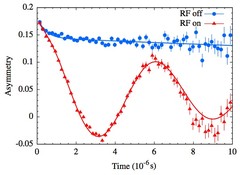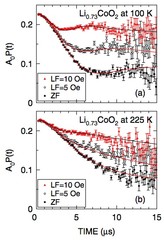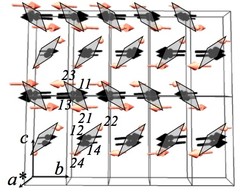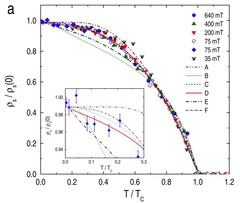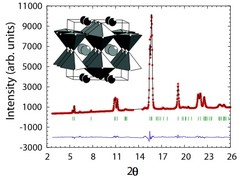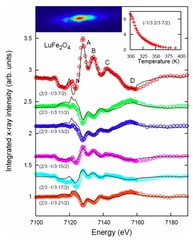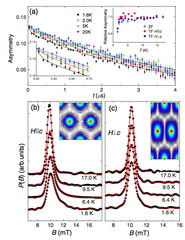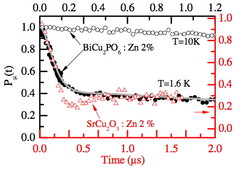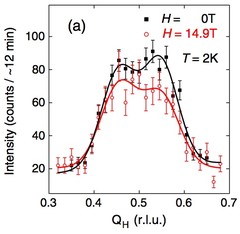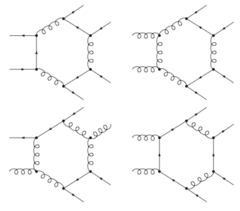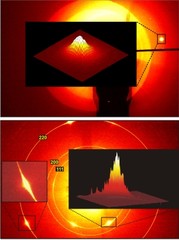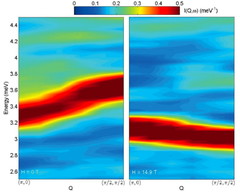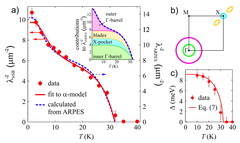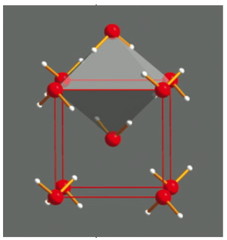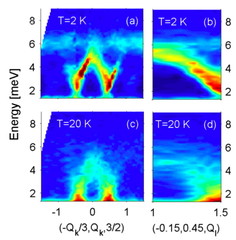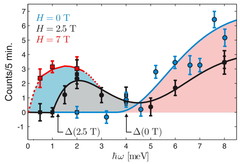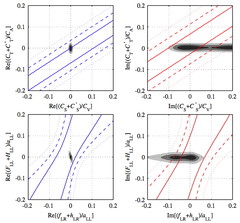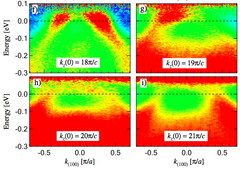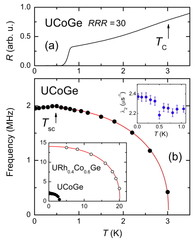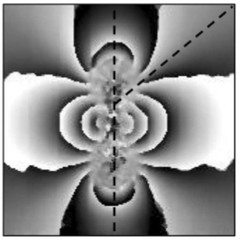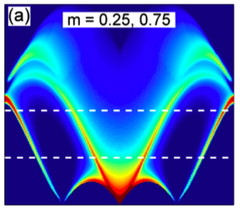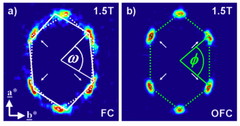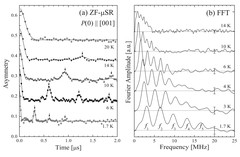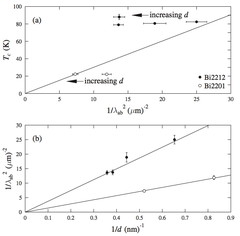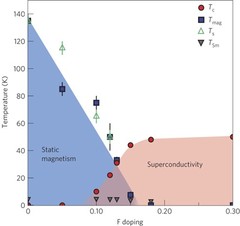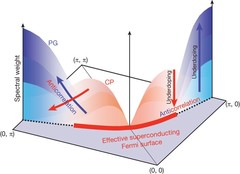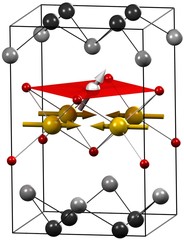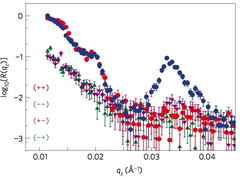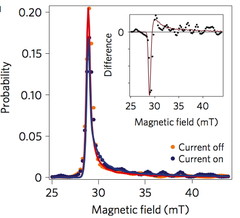Scientific Highlights 2009
Strong H···F Hydrogen Bonds as Synthons in Polymeric Quantum Magnets: Structural, Magnetic, and Theoretical Characterization of [Cu(HF2)(pyrazine)2]SbF6, [Cu2F(HF)(HF2)(pyrazine)4](SbF6)2, and [CuAg(H3F4)(pyrazine)5](SbF6)2
Three Cu2+-containing coordination polymers were synthesized and characterized by experimental (X-ray diffraction, magnetic susceptibility, pulsed-field magnetization, heat capacity, and muon-spin relaxation) and electronic structure studies (quantum Monte Carlo simulations and density functional theory calculations). Read more...
Characterization of the Antiferromagnetism in Ag(pyz)2(S2O8) (pyz = Pyrazine) with a Two-Dimensional Square Lattice of Ag2+ Ions
X-ray powder diffraction and magnetic susceptibility measurements show that Ag(pyz)2(S2O8) consists of 2D square nets of Ag2+ ions resulting from the corner-sharing of axially elongated AgN4O2 octahedra and exhibits characteristic 2D antiferromagnetism. Nevertheless, μ+SR measurements indicate that Ag(pyz)2(S2O8) undergoes 3D magnetic ordering below 7.8(3) K
Electric-Field-Enhanced Neutralization of Deep Centers in GaAs
The charge dynamics of hydrogenlike centers in semi-insulating GaAs have been studied by muon spin resonance in the presence of electric field and RF excitation. Electric-field-enhanced neutralization of deep electron and hole traps by track-induced hot carriers results in an increase of the excess electron's or hole's lifetimes. Similar processes may take place in semiconductor devices working at high voltages and/or under irradiation. As a consequence of the deep traps neutralization, the muonium (µ++e-) center can capture a hole.
Li Diffusion in LixCoO2 Probed by Muon-Spin Spectroscopy
The diffusion coefficient of Li+ ions (DLi) in the battery material LixCoO2 has been investigated by muon-spin relaxation (µ+SR). Based on experiments in zero and weak longitudinal fields at temperatures up to 400 K, we determined the fluctuation rate (nu) of the fields on the muons due to their interaction with the nuclear moments. Combined with susceptibility data and electrostatic potential calculations, clear Li+ ion diffusion was detected above ~150 K. The DLi estimated from 'nu' was in very good agreement with predictions from first-principles calculations, and we present the µ+SR technique as an optimal probe to detect DLi for materials containing magnetic ions.
Spin Amplitude Modulation Driven Magnetoelectric Coupling in the New Multiferroic FeTe2O5Br>
The magnetic and ferroelectric properties of the layered geometrically frustrated cluster compound FeTe2O5Br were investigated with single-crystal neutron diffraction and dielectric measurements. An incommensurate transverse amplitude modulated magnetic order with the wave vector q=(1/2,0.463,0) develops below TN=10.6(2) K. Simultaneously, a ferroelectric order due to exchange striction involving polarizable Te4+ lone-pair electrons develops perpendicular to q and to Fe3+ magnetic moments. The observed magnetoelectric coupling is proposed to originate from the temperature dependent phase difference between neighboring amplitude modulation waves.
Superfluid Density and Energy Gap Function of Superconducting PrPt4Ge12
The filled skutterudite superconductor PrPt4Ge12 was studied in muon-spin rotation (µSR), specific heat, and electrical resistivity experiments. The continuous increase of the superfluid density with decreasing temperature and the dependence of the magnetic penetration depth 'lambda' on the magnetic field obtained by means of µSR, as well as the observation of a T3 dependence of the electronic specific heat indicate the presence of pointlike nodes in the superconducting energy gap. The gap and the specific heat are found to be well described by two models with point nodes, similar to results obtained for the unconventional heavy fermion skutterudite superconductor PrOs4Sb12.
Pressure-Induced Insulator-to-Metal Transition in TbBaCo2O5.48
TbBaCo2O5.48 has been studied by high-pressure synchrotron x-ray diffraction together with resistivity measurements as a function of temperature and pressure. It was found that under pressure a structural phase transition takes place corroborating with a sluggish insulator-to-metal transition. An onset of the metallic state was deduced from a gradual drop of resistivity at the range 3–10 GPa culminating into the change in sign of dR/dT, from negative to positive, at P ≥10 GPa; at the same pressure range there is a change of lattice strain components calculated from the unit cell dimensions. The changes in structural and transport properties are very similar to those found on heating at ambient pressure implying a common mechanism.
Orbital Order at Mn and O Sites and Absence of Zener Polaron Formation in Manganites
We report the doping dependence of the ground state of A-site ordered manganites below and above half doping. Energy and polarization dependence of the orbital reflection, taken by resonant soft-x-ray powder diffraction, at both Mn L2,3 and O K edges, provides direct evidence for orbital order at Mn3+ and oxygen sites and absence of Zener polaron formation. For x ≥ 0.2 anomalous melting of the orbital order is observed, which is coupled neither to magnetic ordering nor to a structural transition, indicating a two-dimensional character of the interactions.
Test of Lorentz Invariance with Spin Precession of Ultracold Neutrons
%LIGHTBOX{"/num/HighlightsNineEN/altarev_prl.jpg" width="280">
A clock comparison experiment, analyzing the ratio of spin precession frequencies of stored ultracold neutrons and 199Hg atoms, is reported. No daily variation of this ratio could be found, from which is set an upper limit on the Lorentz invariance violating cosmic anisotropy field bperpendicular<2×10-20 eV (95% C.L.). This is the first limit for the free neutron. This result is also interpreted as a direct limit on the gravitational dipole moment of the neutron |gn|<0.3 eV/c2 m from a spin-dependent interaction with the Sun. Analyzing the gravitational interaction with the Earth, based on previous data, yields a more stringent limit |gn|<3×10-4 eV/c2m.
Direct Observation of Charge Order and an Orbital Glass State in Multiferroic LuFe2O4
Geometrical frustration of the Fe ions in LuFe2O4 leads to intricate charge and magnetic order and a strong magnetoelectric coupling. Using resonant x-ray diffraction at the Fe K edge, the anomalous scattering factors of both Fe sites are deduced from the (h/3 k/3 l/2) reflections. The chemical shift between the two types of Fe ions equals 4.0(1) eV corresponding to full charge separation into Fe2+ and Fe. The polarization and azimuthal angle dependence of the superlattice reflections demonstrate the absence of differences in anisotropic scattering revealing random orientations of the Fe2+ orbitals characteristic of an orbital glass state.
Superconductivity and Field-Induced Magnetism in SrFe1.75Co0.25As2
Using muon-spin rotation, we studied the in-plane (lambdaab) and the out of plane (lambdac) magnetic field penetration depth in SrFe1.75Co0.25As2 (Tc approx 13.3 K). The penetration depth anisotropy gammalambda=lambdac/lambdaab increases from gammalambda approx 2.1 at Tc to 2.7 at 1.6 K. The mean internal field in the superconducting state increases with decreasing temperature, just opposite to the diamagnetic response seen in magnetization experiments. This unusual behavior suggests that the external field induces a magnetic order which is maintained throughout the whole sample volume.
Collective Magnetic Excitations in the Spin Ladder Sr14Cu24O41 Measured Using High-Resolution Resonant Inelastic X-Ray Scattering
%LIGHTBOX{"/num/HighlightsNineEN/schlappa_prl.gif" width="280">
We investigate magnetic excitations in the spin-ladder compound Sr14Cu24O41 using high-resolution Cu L3 edge resonant inelastic x-ray scattering (RIXS). Our findings demonstrate that RIXS couples to two-triplon collective excitations. In contrast to inelastic neutron scattering, the RIXS cross section changes only moderately over the entire Brillouin zone, revealing high sensitivity also at small momentum transfers, allowing determination of the two-triplon energy gap as 100±30 meV. Our results are backed by calculations within an effective Hubbard model for a finite-size cluster, and confirm that optical selection rules are obeyed for excitations from this spherically symmetric quantum spin-liquid ground state.
Impurity-Induced Magnetic Order in Low-Dimensional Spin-Gapped Materials
We have studied the effect of nonmagnetic Zn impurities in the coupled spin ladder Bi(Cu1-xZnx)2PO6 using 31P NMR, muon spin resonance (µSR), and quantum Monte Carlo simulations. Our results show that the impurities induce in their vicinity antiferromagnetic polarizations, extending over a few unit cells. At low temperature, these extended moments freeze in a process which is found universal among various other spin-gapped compounds: isolated ladders, Haldane, or spin-Peierls chains. This allows us to propose a simple common framework to explain the generic low-temperature impurity-induced freezings observed in low-dimensional spin-gapped materials.
Magnetic-Field-Enhanced Incommensurate Magnetic Order in the Underdoped High-Temperature Superconductor YBa2Cu3O6.45
We present a neutron-scattering study of the static and dynamic spin correlations in the underdoped high-temperature superconductor YBa2Cu3O6.45 in magnetic fields up to 15 T. The field strongly enhances static incommensurate magnetic order at low temperatures and induces a spectral-weight shift in the magnetic-excitation spectrum. A reconstruction of the Fermi surface driven by the field-enhanced magnetic superstructure may thus be responsible for the unusual Fermi surface topology revealed by recent quantum-oscillation experiments.
Next-To-Leading Order QCD Corrections to pp -> tt'bb'+X at the LHC
We report on the calculation of the full next-to-leading-order QCD corrections to the production of tt'bb' final states at the LHC, which deliver a serious background contribution to the production of a Higgs boson (decaying into a bb' pair) in association with a tt' pair. While the corrections significantly reduce the unphysical scale dependence of the leading-order cross section, our results predict an enhancement of the tt'bb' production cross section by a K factor of about 1.8.
On the Microstructure of Nanoporous Gold: An X-ray Diffraction Study
The evolution of the grain structure, internal strain, and the lattice misorientations of nanoporous gold during dealloying of bulk (3D) Ag−Au alloy samples was studied for the first time by various in situ and ex situ X-ray diffraction techniques including powder and Laue diffraction. The experiments reveal that the dealloying process preserves the original crystallographic structure but leads to a small spread in orientations within individual grains. Initially, most grains develop in-plane tensile stresses, which are partly released during further dealloying. Simultaneously, the feature size of the developing nanoporous structure increases with increasing dealloying time. Finally, microdiffraction experiments on dealloyed micron-sized nanoporous pillars reveal significant surface damage introduced by focused ion beam milling.
Quantum Effects in a Weakly Frustrated S=1/2 Two-Dimensional Heisenberg Antiferromagnet in an Applied Magnetic Field
We have studied the two-dimensional S=1/2 square-lattice antiferromagnet Cu(pz)2(ClO4)2 (where pz denotes pyrazine), using neutron inelastic scattering and series expansion calculations. We show that the presence of antiferromagnetic next-nearest-neighbor interactions enhances quantum fluctuations associated with resonating valence bonds. Intermediate magnetic fields lead to a selective tuning of resonating valence bonds and a spectacular inversion of the zone-boundary dispersion, providing novel insight into 2D antiferromagnetism in the quantum limit.
Two-Gap Superconductivity in Ba1-xKxFe2As2: A Complementary Study of the Magnetic Penetration Depth by Muon-Spin Rotation and Angle-Resolved Photoemission
We investigate the magnetic penetration depth lambda in superconducting Ba1-xKxFe2As2 (Tc approx 32 K) with muon-spin rotation (µSR) and angle-resolved photoemission (ARPES). Using µSR, we find the penetration-depth anisotropy gamma_lambda = lambda_c / lambda_ab and the second-critical-field anisotropy gamma_Hc2 to show an opposite T evolution below Tc. This dichotomy resembles the situation in the two-gap superconductor MgB2. A two-gap scenario is also suggested by an inflection point in the in-plane penetration depth lambda_ab around 7 K. The complementarity of µSR and ARPES allows us to pinpoint the values of the two gaps and to arrive to a remarkable agreement between the two techniques concerning the full T evolution of lambda_ab. This provides further support for the described scenario and establishes ARPES as a tool to assess macroscopic properties of the superconducting condensate.
The preparation and structure of salty ice VII under pressure
It is widely accepted that ice, no matter what phase, is unable to incorporate large amounts of salt into its structure. This conclusion is based on the observation that on freezing of salt water, ice expels the salt almost entirely as brine. Here, we show that this behaviour is not an intrinsic physico-chemical property of ice phases. We demonstrate by neutron diffraction that substantial amounts of dissolved LiCl can be built homogeneously into the ice VII structure if it is produced by recrystallization of its glassy (amorphous) state under pressure. Such alloyed ice VII has significantly different structural properties compared with pure ice VII, such as an 8% larger unit cell volume, 5 times larger displacement factors, an absence of a transition to an ordered ice VIII structure and plasticity. Our study suggests that there could be a whole new class of salty high-pressure ice forms.
Anomalous Magnetic Excitations of Cooperative Tetrahedral Spin Clusters
An inelastic neutron scattering study of Cu2Te2O5X2 (X=Cl, Br) shows strong dispersive modes with large energy gaps persisting far above TN, notably in Cu2Te2O5Br2. The anomalous features: a coexisting unusually weak Goldstone-like mode observed in Cu2Te2O5Cl2 and the size of the energy gaps cannot be explained by existing theories, such as our mean-field or random-phase approximation. We argue that our findings represent a new general type of behavior due to intercluster quantum fluctuations and call for development of a new theoretical approach.
Magnetic-Field-Induced Soft-Mode Quantum Phase Transition in the High-Temperature Superconductor La1.855Sr0.145CuO4: An Inelastic Neutron-Scattering Study
Inelastic neutron-scattering experiments on the high-temperature superconductor La1.855Sr0.145CuO4 reveal a magnetic excitation gap Delta that decreases continuously upon application of a magnetic field perpendicular to the CuO2 planes. The gap vanishes at the critical field required to induce long-range incommensurate antiferromagnetic order, providing compelling evidence for a field-induced soft-mode driven quantum phase transition.
Measurement of the Transverse Polarization of Electrons Emitted in Free-Neutron Decay
Both components of the transverse polarization of electrons (sigma_T1, sigma_T2) emitted in the beta-decay of polarized, free neutrons have been measured. The T-odd, P-odd correlation coefficient quantifying sigma_T2, perpendicular to the neutron polarization and electron momentum, was found to be R=0.008±0.015±0.005. This value is consistent with time reversal invariance and significantly improves limits on the relative strength of imaginary scalar couplings in the weak interaction. The value obtained for the correlation coefficient associated with sigma_T1, N=0.056±0.011±0.005, agrees with the Standard Model expectation, providing an important sensitivity test of the experimental setup.
Three- to Two-Dimensional Transition of the Electronic Structure in CaFe2As2: A Parent Compound for an Iron Arsenic High-Temperature Superconductor
We use angle-resolved photoemission spectroscopy (ARPES) to study the electronic properties of CaFe2As2—parent compound of a pnictide superconductor. We find that the structural and magnetic transition is accompanied by a three- to two-dimensional (3D-2D) crossover in the electronic structure. Above the transition temperature (Ts) Fermi surfaces around Gamma and X points are cylindrical and quasi 2D. Below Ts, the Gamma pocket forms a 3D ellipsoid, while the X pocket remains quasi 2D. This finding strongly suggests that low dimensionality plays an important role in understanding the superconducting mechanism in pnictides.
Muon Spin Rotation and Relaxation in the Superconducting Ferromagnet UCoGe
We report zero-field muon-spin rotation and relaxation measurements on the superconducting ferromagnet UCoGe. Weak itinerant ferromagnetic order is detected by a spontaneous muon-spin precession frequency below the Curie temperature TC=3 K. The µ+ precession frequency persists below the bulk superconducting transition temperature Tsc=0.5 K, where it measures a local magnetic field Bloc=0.015 T. The amplitude of the µSR signal provides unambiguous proof for ferromagnetism present in the whole sample volume. We conclude ferromagnetism coexists with superconductivity on the microscopic scale.
Quantitative Radiography of Magnetic Fields Using Neutron Spin Phase Imaging
We report on a novel neutron radiography technique that uses the Ramsey principle, a method similar to neutron spin echo. For the first time quantitative imaging measurements of magnetic objects and fields could be performed. The strength of the spin-dependent magnetic interaction is detected by a change in the Larmor precession frequency of the neutron spins. Hence, one obtains in addition to the normal attenuation radiography image a so-called neutron spin phase image, which provides a two-dimensional projection of the magnetic field integrated over the neutron flight path.
Electronic Phase Separation in the Slightly Underdoped Iron Pnictide Superconductor Ba1-xKxFe2As2
Here we present a combined study of the slightly underdoped novel pnictide superconductor Ba1-xKxFe2As2 by means of x-ray powder diffraction, neutron scattering, muon-spin rotation (µSR), and magnetic force microscopy (MFM). Static antiferromagnetic order sets in below Tm70 K as inferred from the neutron scattering and zero-field-µSR data. Transverse-field µSR below Tc shows a coexistence of magnetically ordered and nonmagnetic states, which is also confirmed by MFM imaging. We explain such coexistence by electronic phase separation into antiferromagnetic and superconducting- or normal-state regions on a lateral scale of several tens of nanometers. Our findings indicate that such mesoscopic phase separation can be considered an intrinsic property of some iron pnictide superconductors.
Direct Observation of Magnon Fractionalization in the Quantum Spin Ladder
We measure by inelastic neutron scattering the spin excitation spectra as a function of applied magnetic field in the quantum spin-ladder material (C5H12N)2CuBr4. Discrete magnon modes at low fields in the quantum disordered phase and at high fields in the saturated phase contrast sharply with a spinon continuum at intermediate fields characteristic of the Luttinger-liquid phase. By tuning the magnetic field, we drive the fractionalization of magnons into spinons and, in this deconfined regime, observe both commensurate and incommensurate continua.
Fermi Surface and Order Parameter Driven Vortex Lattice Structure Transitions in Twin-Free YBa2Cu3O7
We report on small-angle neutron scattering studies of the intrinsic vortex lattice (VL) structure in detwinned YBa2Cu3O7 at 2 K, and in fields up to 10.8 T. Because of the suppressed pinning to twin-domain boundaries, a new distorted hexagonal VL structure phase is stabilized at intermediate fields. It is separated from a low-field hexagonal phase of different orientation and distortion by a first-order transition at 2.0(2) T that is probably driven by Fermi surface effects. We argue that another first-order transition at 6.7(2) T, into a rhombic structure with a distortion of opposite sign, marks a crossover from a regime where Fermi surface anisotropy is dominant, to one where the VL structure and distortion is controlled by the order-parameter anisotropy.
Quantized Hyperfine Field at an Implanted µ+ Site in PrPb3: Interplay between Localized f Electrons and an Interstitial Charged Particle
The local effect of an interstitial hydrogenlike particle on localized f electrons was studied in PrPb3 by means of µ+ spin rotation and relaxation. Spontaneous µ+ spin precession with harmonic frequencies was observed for the first time in f electron compounds. We demonstrate that the signal is derived from a coupling between the µ+ spin and the hyperfine-enhanced nuclear spin of nearest neighbor (NN) 141Pr with Ising-like anisotropy. The signal also suggests a marked suppression of spin dynamics of the NN 141Pr in comparison with that of the bulk 141Pr. These facts strongly indicate modification of the f electronic state due to the interstitial charged particle.
Tuning the Interlayer Spacing of High-Tc Bi-Based Superconductors by Intercalation: Measuring the Penetration Depth and the Two-Dimensional Superfluid Density
Substantial control of the interlayer spacing in Bi-based high temperature superconductors has been achieved through the intercalation of guest molecules between the superconducting layers. Measurements using implanted muons reveal that the penetration depth increases with increasing layer separation while Tc does not vary appreciably, demonstrating that the bulk superfluid density is not the determining factor controlling Tc. Our results strongly suggest that for Bi-based high temperature superconductors the superfluid density appearing in the Uemura scaling relation rho_s prop Tc should be interpreted as the two-dimensional density within the superconducting layers, which we find to be constant for each class of system investigated.
Coexistence of static magnetism and superconductivity in SmFeAsO1-xFx as revealed by muon spin rotation
The recent observation of superconductivity with critical temperatures (Tc) up to 55 K in the pnictide RFeAsO1-xFx, where R is a lanthanide, marks the first discovery of a non-copper-oxide-based layered high-Tc superconductor. It has raised the suspicion that these new materials share a similar pairing mechanism to the cuprate superconductors, as both families exhibit superconductivity following charge doping of a magnetic parent material. In this context, it is important to follow the evolution of the microscopic magnetic properties of the pnictides with doping and hence to determine whether magnetic correlations coexist with superconductivity. Here, we present a muon spin rotation study on SmFeAsO1-xFx, with x=0–0.30 that shows that, as in the cuprates, static magnetism persists well into the superconducting regime. This analogy is quite surprising as the parent compounds of the two families have rather different magnetic ground states: itinerant spin density wave for the pnictides contrasted with the Mott–Hubbard insulator in the cuprates. Our findings therefore suggest that the proximity to magnetic order and associated soft magnetic fluctuations, rather than strong electronic correlations in the vicinity of a Mott–Hubbard transition, may be the key ingredients of high-Tc superconductors.
Competition between the pseudogap and superconductivity in the high-Tc copper oxides
In a classical Bardeen–Cooper–Schrieffer superconductor, pairing and coherence of electrons are established simultaneously below the critical transition temperature (T c), giving rise to a gap in the electronic energy spectrum. In the high-T c copper oxide superconductors, however, a pseudogap extends above T c. The relationship between the pseudogap and superconductivity is one of the central issues in this field. Spectral gaps arising from pairing precursors are qualitatively similar to those caused by competing electronic states, rendering a standard approach to their analysis inconclusive. The issue can be settled, however, by studying the correlation between the weights associated with the pseudogap and superconductivity spectral features. Here we report a study of two spectral weights using angle-resolved photoemission spectroscopy. The weight of the superconducting coherent peak increases away from the node following the trend of the superconducting gap, but starts to decrease in the antinodal region. This striking non-monotonicity reveals the presence of a competing state. We demonstrate a direct correlation, for different values of momenta and doping, between the loss in the low-energy spectral weight arising from the opening of the pseudogap and a decrease in the spectral weight associated with superconductivity. We therefore conclude that the pseudogap competes with the superconductivity by depleting the spectral weight available for pairing.
The electronic phase diagram of the LaO1-xFxFeAs superconductor
The competition of magnetic order and superconductivity is a key element in the physics of all unconventional superconductors, for example in high-transition-temperature cuprates1, heavy fermions2 and organic superconductors3. Here superconductivity is often found close to a quantum critical point where long-range antiferromagnetic order is gradually suppressed as a function of a control parameter, for example charge-carrier doping or pressure. It is believed that dynamic spin fluctuations associated with this quantum critical behaviour are crucial for the mechanism of superconductivity. Recently, high-temperature superconductivity has been discovered in iron pnictides, providing a new class of unconventional superconductors4, 5, 6. Similar to other unconventional superconductors, the parent compounds of the pnictides show a magnetic ground state7, 8 and superconductivity is induced on charge-carrier doping. In this Letter the structural and electronic phase diagram is investigated by means of X-ray scattering, muon spin relaxation and Mössbauer spectroscopy on the series LaO1-xFxFeAs. We find a discontinuous first-order-like change of the Néel temperature, the superconducting transition temperature and the respective order parameters. Our results strongly question the relevance of quantum critical behaviour in iron pnictides and prove a strong coupling of the structural orthorhombic distortion and the magnetic order both disappearing at the phase boundary to the superconducting state.
Giant superconductivity-induced modulation of the ferromagnetic magnetization in a cuprate–manganite superlattice
Artificial multilayers offer unique opportunities for combining materials with antagonistic orders such as superconductivity and ferromagnetism and thus to realize novel quantum states. In particular, oxide multilayers enable the utilization of the high superconducting transition temperature of the cuprates and the versatile magnetic properties of the colossal-magnetoresistance manganites. However, apart from exploratory work, the in-depth investigation of their unusual properties has only just begun. Here we present neutron reflectometry measurements of a [Y0.6Pr0.4Ba2Cu3O7 (10 nm)/La2/3Ca1/3MnO3 (10 nm)]10 superlattice, which reveal a surprisingly large superconductivity-induced modulation of the vertical ferromagnetic magnetization profile. Most surprisingly, this modulation seems to involve the density rather than the orientation of the magnetization and is highly susceptible to the strain, which is transmitted from the SrTiO3 substrate. We outline a possible explanation of this unusual superconductivity-induced phenomenon in terms of a phase separation between ferromagnetic and non-ferromagnetic nanodomains in the La2/3Ca1/3MnO3 layers.
Direct measurement of the electronic spin diffusion length in a fully functional organic spin valve by low-energy muon spin rotation
Electronic devices that use the spin degree of freedom hold unique prospects for future technology. The performance of these 'spintronic' devices relies heavily on the efficient transfer of spin polarization across different layers and interfaces. This complex transfer process depends on individual material properties and also, most importantly, on the structural and electronic properties of the interfaces between the different materials and defects that are common to real devices. Knowledge of these factors is especially important for the relatively new field of organic spintronics, where there is a severe lack of suitable experimental techniques that can yield depth-resolved information about the spin polarization of charge carriers within buried layers of real devices. Here, we present a new depth-resolved technique for measuring the spin polarization of current-injected electrons in an organic spin valve and find the temperature dependence of the measured spin diffusion length is correlated with the device magnetoresistance.


